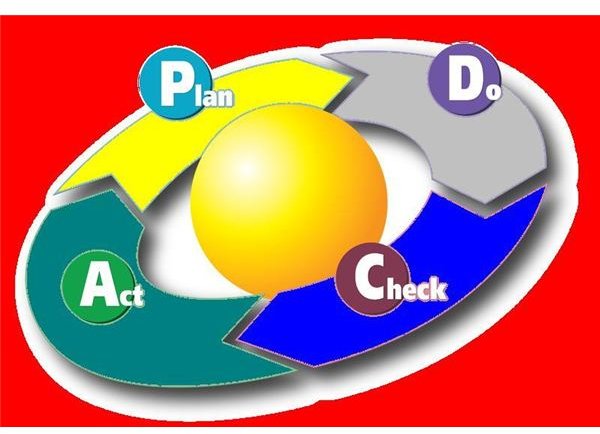The Application of PDCA for Quality Management
The PDCA (Plan-Do-Check-Act) model first introduced by Walter Shewhart in 1929 and popularized by W. Edwards Deming in the 1950s as “a flow diagram for learning, and for improvement of a product and a process”. Deming advocated the use of PDCA as a continuous feedback loop to analyze, measure, and identify sources of variations from customer requirements and take corrective action.
The application of PDCA as a tool to implement Total Quality Management and Six Sigma has made PDCA fundamental to the tenet of quality management. PDCA is one approach toward Total Quality Management, and the basis on which Six Sigma’s DMAIC model rests. The PDCA cycle provides a feedback mechanism for continual quality improvement.
PDCA for quality management entails ensuing consistency across consecutive business activities.
Image Source: Wikimedia Commons/karn b
PLAN
The “Plan” phase of PDCA for quality management covers:
- defining the problem or issue that requires redress
- defining the ideal or desired state
- data collection to determine the problem in terms of deviance from the ideal state
- ascertaining the root cause for the problem or issue
- evaluating the various possible interventions to solve the problem and their possible outcomes
- selecting the best possible intervention
- scheduling the corrective process by planning for resources, determining people responsible for the corrective action
- mapping the corrective process through flowcharts, control charts, and other tools
DO
The “Do” phase of PDCA concerns implementation of the selected solution to reduce the deviation or solve the issue. The implementation of the selected solution is initially on a small scale to check its effectiveness. Successful implementation results in across-the-board implementation.
This phase also covers training the employees for the adopted quality intervention.
CHECK
In traditional quality management schemes, the “Check” of PDCA became synonymous with quality inspection. The methodology entails defining workmanship standards such as upper specification limit (USL) and lower specification limit (LSL) and then comparing the product specifications against such standards. The inspection would weed out unacceptable products.
Deming replaced the “Check” stage with “Study” stage that entails use of statistical tools to understanding the nature of variation in the process output in terms of what worked, what did not work, and the lessons learned from the experience.
ACT
The “Act” phase in PDCA for quality management entails:
- standardization of the successful solution and adopting the same for wholesale process improvement
involving other stakeholders such as other departments, suppliers and customers in the changed process
creating safeguards to check relapse into the previous stage
explore opportunities for further improvements
Different Approaches towards PDCA for Quality Management
Although the basic structure of PDCA remains constant, the application of PDCA to improve quality takes various approaches. The two major approaches are Edwards Deming’s Statistical Control Approach and Genichi Taguchi’s Robust Engineering Approach.
Edward Deming applied PDCA to reduce excessive variability in processes and products by using statistical tools. Taguchi tried to avoid variability by targeting it in the planning phase using robust engineering solutions to achieve performance on target.
Whatever the approach, the PDCA model helps in quality management on a day-to-day basis. It keeps the process under control, prevents non-conformance, and encourages development of innovative and breakthrough changes to ensure quality and performance improvement.
The PDCA approach toward Quality Management is a continuous approach. Increased quality leads to increased customer expectations, which in turn drives further product and process improvement.
References
- Deming, W. Edwards (1986). Out of the Crisis. MIT Center for Advanced Engineering Study. ISBN 0-911379-01-0.
- American Society for Quality. Plan–Do–Check–Act Cycle
- Mindtools.com. Plan-Do-Check-Act (PDCA).
